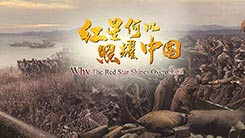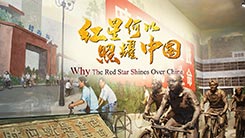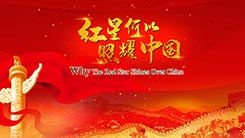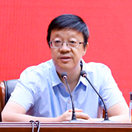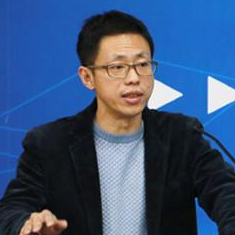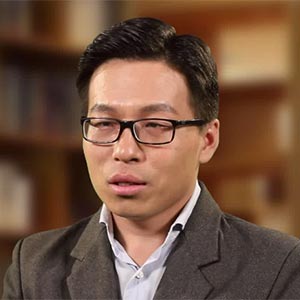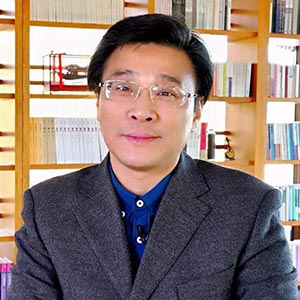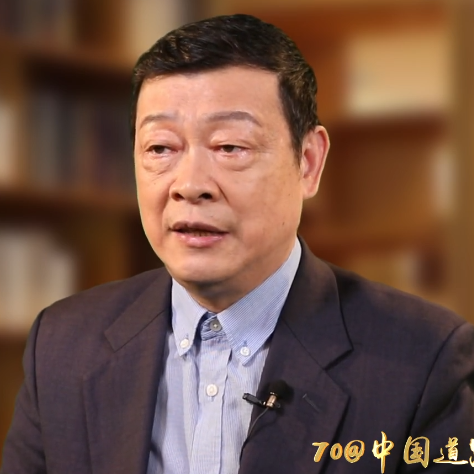为什么是马克思主义?为什么是中国共产党?
中华民族有着五千多年的文明发展史。
在漫长的历史长河中,勤劳智慧的中国人民创造了灿烂的中华文明。
但从 1840年开始,西方帝国主义列强通过发动侵略战争,强迫中国割地、赔款。
中国人民生活在水深火热之中,展现在中华民族面前的是一片濒临毁灭的悲惨黯淡的前景。
近代中国的仁人志士,为了捍卫民族独立和尊严,捍卫中华文明,从未停止过英勇抗争。
这期间发生了太平天国起义、洋务运动、戊戌维新运动、义和团运动。
但是,由于没有找到科学的理论、正确的道路和可依靠的社会力量,这些斗争一次又一次地失败了。
1911年 10月孙中山领导的辛亥革命,终于推翻了清王朝统治,建立了中华民国,结束了统治中国几千年的封建帝制。
但辛亥革命并没有改变中国人民被压迫奴役的悲惨境遇。
以袁世凯为首的北洋军阀窃取了辛亥革命的果实,中国陷入四分五裂的军阀割据和军阀混战之中。
这期间,在中国的政治舞台上出现过帝制复辟、议会制、多党制、总统制等各种形式,各种政治势力及其代表人物纷纷登场,旧中国的社会性质和中国人民的悲惨命运没有改变。
历史呼唤着真正能够带领中华民族实现伟大复兴使命的承担者,这个任务光荣地落到了先进生产力的代表 ——中国工人阶级及其政党的肩上。
面对辛亥革命后的社会现实,以陈独秀和李大钊为代表的中国先进的知识分子毅然举起民主与科学的旗帜,掀起了新文化运动。
新文化运动提倡民主和科学,打开了遏制新思想涌流的闸门,在中国社会掀起一股思想解放的潮流。
与此同时,1917年,列宁领导的布尔什维克党发动了震撼世界的十月社会主义革命,在世界上建立了第一个社会主义国家。
在十月革命的推动下,各国共产党纷纷建立,共产主义运动迅速扩展到全世界。
1919年3月,无产阶级的国际性组织——共产国际成立。
这年5月 4日,北京学生 3000余人齐集天安门前举行示威。
他们冲破反动军警的阻挠,从四面八方汇聚到天安门前,举行抗议集会,这就是震惊中外的五四运动。
陈独秀、李大钊作为中国新文化运动的主要发起人,他们在1919年五四运动期间毅然选择了马克思主义和俄国十月革命道路,是中国共产党的主要创始人。
在上海与北京党组织的联络推动下,各地党的早期组织纷纷建立起来。
1920年7月,一批留法的勤工俭学生在蒙达尼公学集会。
蔡和森在会上“主张激烈的革命,组织共产党,实行无产阶级专政,即仿效俄国十月革命的方法”。
这年的8月,蔡和森在给毛泽东的信中提出“明目张胆正式成立一个中国共产党”。
毛泽东回信称:“你这封信见地极当,我没有一个字不赞成。”“中国共产党”的名字也由此而来。
1921年7月23日,中国共产党第一次全国代表大会在上海法租界望志路106号举行,在浙江嘉兴南湖“红船”上闭幕。
中国共产党正式成立!
中国共产党的诞生,是近代中国历史发展的必然结果,也是中国人民在救亡图存斗争中顽强求索的必然结果,也是中华民族在追求伟大复兴道路上不断觉醒的必然结果。
此后28年时间里,经过艰苦卓绝的奋斗以及人民的支持,中国共产党成为中国的执政党。
时至今日,一百年间,中国共产党带领中国人民,深刻改变了近代以后中华民族发展的方向和进程,深刻改变了中国人民和中华民族的前途和命运,深刻改变了世界发展的趋势和格局。
Why did We Choose Marxism? Why did the CPC Take Up the Mission?
The Chinese nation has a civilization that dates back more than 5,000 years.
During the long history, the diligent and intelligent Chinese people have created a splendid culture.
From 1840, however, the western imperialist powers launched a series of aggressive wars, and forced China to cede its territories and pay reparations.
The Chinese people were living in dire straits, and the Chinese nation facing tragic and bleak prospects was on the verge of destruction.
In modern times, people with lofty ideals had never stopped fighting bravely to defend the independence and dignity of the nation, and the Chinese civilization.
During that period, the Taiping Rebellion, the Westernization Movement, the Reform Movement of 1898, and the anti-western Boxer Rebellion broke out.
Due to a lack of scientific theory, correct path, and reliable social forces, these struggles failed time and time again.
In October 1911, the Xinhai Revolution led by Dr. Sun Yat-sen finally overthrew the Qing Dynasty and established the Republic of China, hence ending the autocratic monarchy that had ruled China for more than 2,000 years.
The Revolution, however, did not change the miserable plight of the Chinese people under oppression and suppression.
The Beiyang warlords headed by Yuan Shikai usurped what the Xinhai Revolution achieved, and China fell into a fragmented warlord regime and melee.
During this period, various political systems such as imperial restoration, parliamentary system, multi-party system, and presidential system stepped on the political arena of China. Many political forces and their representatives also came on stage. Nevertheless, neither the social nature of the old China nor the tragic fate of the Chinese people changed.
History called for those who could truly take up the mission to realize the great rejuvenation of the Chinese nation. This task fell gloriously on the shoulders of the representatives of advanced productive forces — the Chinese working class and its political party.
Facing the social reality after the Xinhai Revolution, China's outstanding intellectuals represented by ChenDuxiu and Li Dazhao resolutely raised high the banner of democracy and science, and kicked off the New Culture Movement.
Advocating the western ideas of science and democracy, the New Culture Movement lifted the restrictions on new thoughts and started an emancipation of minds in Chinese society.
Around the same time, in 1917, the Bolshevik Party led by Vladimir Lenin launched the October Socialist Revolution in Russia, which astonished the world. The first socialist country was then established.
Motivated by the October Revolution, the Communist Parties of various countries were founded one after another, and the communist movement rapidly spread across the whole world.
In March 1919, the Communist International — the international organization of the proletariat — was founded.
On May 4th of that year, more than 3,000 students from Beijing gathered at Tiananmen Square to hold a demonstration.
They broke through the obstructions of the reactionary military and assembled from all sides at Tiananmen Square to hold a protest rally. This was the May Fourth Movement that shocked the country and the world.
As the main initiators of the Chinese New Culture Movement, Chen Duxiu and Li Dazhao resolutely chose to follow the steps of Marxism and the October Revolution during the May Fourth Movement in 1919. They were also the main founders of the Communist Party of China (CPC).
Promoted by the party organizations in Beijing and Shanghai, early party organizations were set up one after another in the rest of the country.
In July 1920, a group of Chinese students who had been sent to study and work in France gathered at Montargis College.
At the meeting, Cai Hesen said, "We should imitate the Russian October Revolution to launch fierce revolution, organize the Communist Party, and implement the dictatorship of the proletariat."
In August of the same year, Cai Hesen proposed in a letter to Mao Zedong "to formally establish a Communist Party of China."
Mao Zedong wrote back, saying: "You are highly perceptive, and not a word do I disagree with in this letter." The name "Communist Party of China" was also first mentioned in the letter.
On July 23, 1921, the First National Congress of the CPC was held at No. 106 Wangzhi Road in the French Concession of Shanghai. It closed on the Red Boat on Nanhu Lake in Jiaxing, Zhejiang province.
The CPC was officially established!
The birth of the CPC is the inevitable result of the development of modern Chinese history, of the people's tenacious struggle for survival, and of the nation's pursuit of the great rejuvenation.
In the next 28 years, after arduous struggle and the support of the people, the CPC became the ruling party of China.
Over the past 100 years, the CPC has led the Chinese people to profoundly change the direction and process of contemporary China's development, the future and destiny of the nation, and the trend and pattern of world development.
《红星何以照耀中国》 / 中国网出品
出品人 / 王晓辉
总监制 / 杨新华
总策划 / 蔡晓娟
执行策划 / 蒋新宇
专家顾问 / 陈述 中共中央党校教授 陈中奎 中国人民解放军国防大学副教授
导演 / 仇俊博
编导 / 申罡 时畅 郭泽涵 鲁波 孔竟泽
设计 / 顾榕楠
制作 / 马跃
翻译 / 汪玮 李秀宇
摄影 / 陶世欣 毛欢东
后期 / 于舜源 傅华洋

